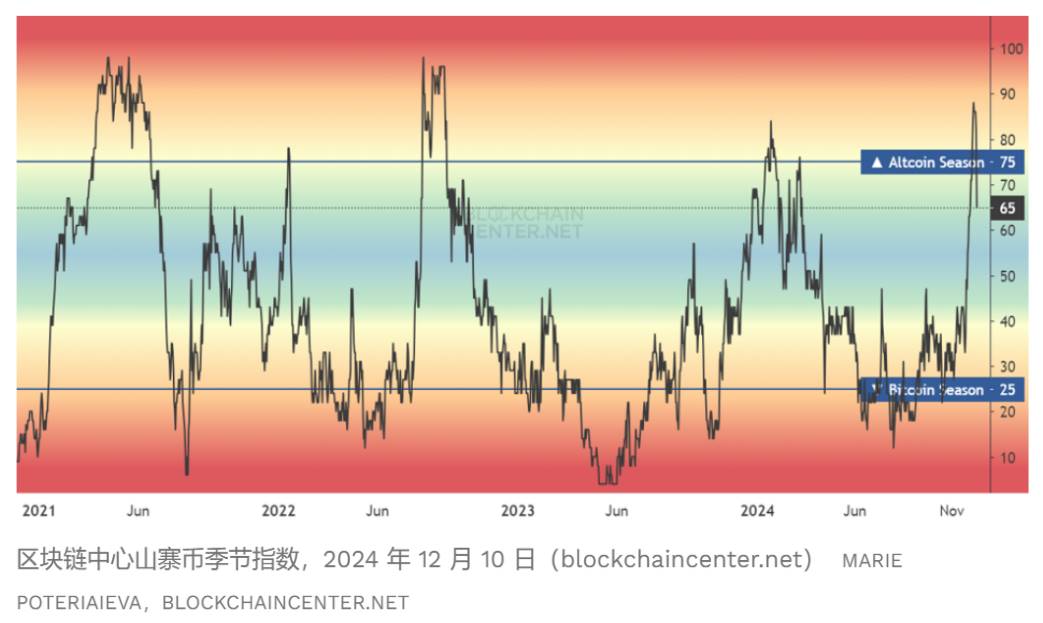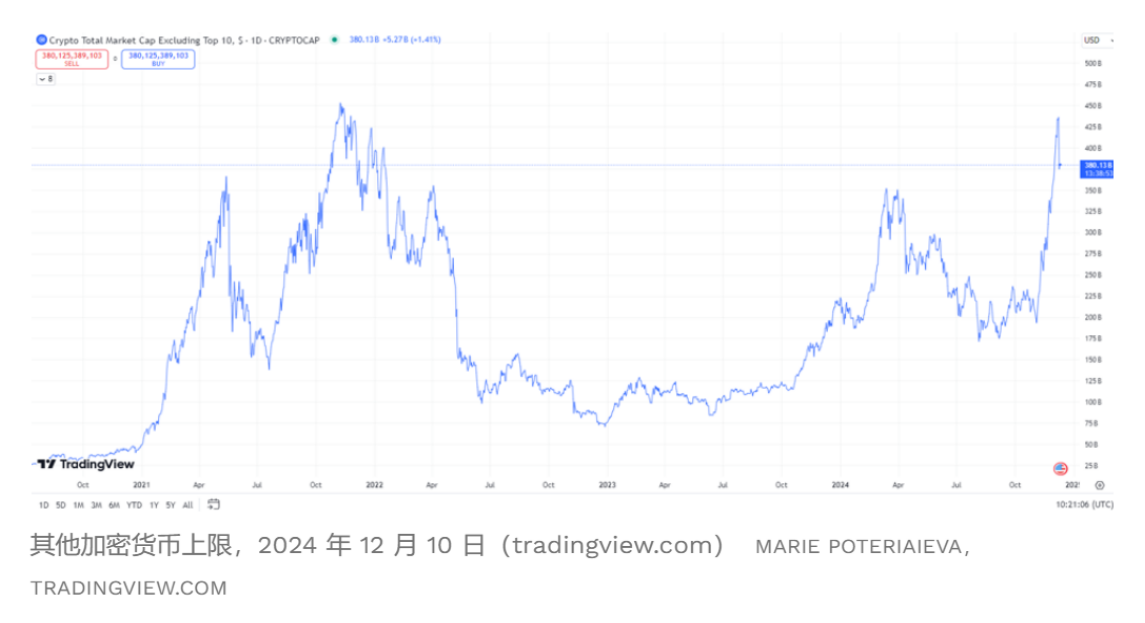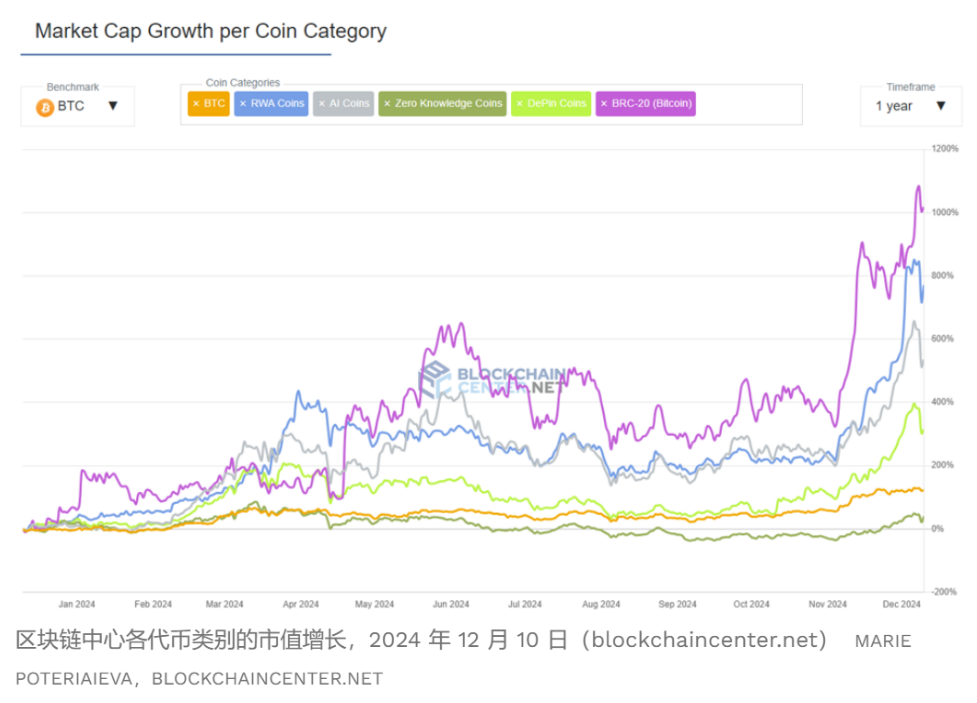Emerging technologies and investment trends may further drive this wave of growth in 2025.
Written by: Marie Poteriaieva
Translation: Plain Language Blockchain

Bitcoin broke through the $100,000 mark last week, undoubtedly a historic milestone. However, as this leading cryptocurrency celebrates its achievement, many altcoins have begun to outperform Bitcoin, signaling the arrival of altcoin season.
Since the beginning of the year, among the top 50 cryptocurrencies by market capitalization, 20 have seen gains exceeding Bitcoin's impressive 124% increase. The rise in altcoin market capitalization, increased media attention, and the climbing altcoin season index further confirm this trend. Additionally, a recent report from CCData shows that trading volume in November reached an annual high, with open interest also hitting record levels. These signs indicate that market risk appetite is on the rise. Such a shift typically favors altcoins, as they have a higher potential for returns.
On a deeper level, investing in altcoins is essentially investing in Web3 and other blockchain-related industries. This sector heavily relies on regulatory clarity, and following the U.S. elections, the market has become more optimistic about this. Furthermore, according to the latest data from CryptoQuant, altcoin trading volume is not driven by BTC trading pairs. This means the market is experiencing genuine growth, rather than just a rotation of assets from Bitcoin to altcoins. It may also suggest that this altcoin season does not have to wait for Bitcoin price consolidation, but could see both types of crypto assets rising simultaneously.
The altcoin rebound since November seems to indicate that 2025 will usher in a larger-scale altcoin season. Emerging crypto trends and technologies may attract the attention of institutional investors and venture capital. Below are speculations on the potential and key narratives of the next altcoin season based on on-chain data and other trends.
1. Altcoin Season is Not Just About Price
Altcoin season is typically defined as a phase where altcoins consistently outperform Bitcoin. This phase often occurs in the final year of Bitcoin's four-year cycle, when market enthusiasm spreads from Bitcoin to other coins, leading large-cap altcoins to approach or exceed their historical highs, while new narratives drive mid- and small-cap coins to break unknown highs. Ultimately, this phase culminates in widespread FOMO (fear of missing out), pushing the entire crypto market into an overheated state. Such overheating usually signals an impending market correction, eventually leading into a bear market cycle.
However, altcoin season is not solely about price; it represents a comprehensive evolution of market activity, application adoption, and innovation. To date, each round of altcoin season has reflected unique technological transformations and market trends.
The first round of altcoin season in 2017 was marked by the ICO boom and the rise of NFTs (remember CryptoKitties?). The second round in 2021 integrated the rise of DeFi along with the explosive growth of NFTs and gaming. To support these developments, cheaper and more scalable Layer 2 solutions emerged. All these innovations have withstood the test of the crypto winter and continue to evolve today.
Looking ahead, the third round of altcoin season in 2025 is expected to bring new narratives and technologies, some of which are already in development, while others have yet to emerge.
2. Indicators of Altcoin Season
Multiple indicators suggest that altcoin season is on the horizon. Bitcoin's dominance is declining, and altcoins are outperforming Bitcoin, with their market capitalization reaching new highs. However, the Altcoin Season Index and other related indicators show that the peak for altcoins may not have arrived yet.
In absolute terms, the total market capitalization of altcoins, calculated by subtracting Bitcoin's market cap from the total crypto market cap, has reached an all-time high. According to Coingecko data, the current market cap stands at $1.89 trillion, surpassing the $1.79 trillion peak set in November 2021. In relative terms, Bitcoin's dominance has dropped from 60% to 51% since November.
However, both of these metrics include stablecoins and wrapped assets. While they are crucial for market liquidity, they may not accurately reflect the development of the altcoin market. Additionally, under bullish conditions, these types of assets tend to favor altcoins due to their higher risk-reward characteristics.
To measure the market more purely, the Altcoin Season Index from Blockchain Center excludes stablecoins and wrapped assets. This index defines altcoin season as a period in which over 75% of the top 50 altcoins outperform Bitcoin over the past 90 days. Recently, this index surpassed the 75% threshold on December 2 and maintained that level for a week. In the previous altcoin season, the index remained above the threshold for nearly three months. This supports the view that the peak of altcoin season may occur in 2025.

The OTHERS index, calculated by platforms like TradingView, is another important metric for measuring altcoin performance. This index tracks the total market capitalization of the crypto market after excluding the top ten coins (including the two largest stablecoins). Although this index rose by 123% over the past 30 days (followed by a pullback), it has not yet reached its previous historical high. The last time it rose from the historical high in 2017, it increased by 525%, indicating there is still considerable room for growth.

Finally, Google Trends also reflects interest in altcoins. With a peak in May 2021 (index at 100), the current search interest has risen to 87, the highest level since then.
3. Key Narratives for Altcoins in 2025
As of 2024, among the top 50 altcoins currently performing best, three are Memecoins: Dogwifhat (WIF +2,027%), PEPE (+1,764%), and Dogecoin (DOGE +382%). Although Memecoins often symbolize altcoin season, they are unlikely to define the mainstream narrative of the crypto market in 2025.
According to data from Blockchain Center, the best-performing new technology emerging in 2023-2024 is the BRC-20 Token. While some do not consider it a true altcoin, these tokens issued on the Bitcoin blockchain, utilizing technologies like Ordinals or Runes, have seen gains exceeding 1000% this year. In the more traditional altcoin category, RWAs (tokenization of real-world assets) leads with a 717% annual growth rate, including tokenized versions of real-world assets and their supporting protocols. Following closely are AI-related tokens (+513%) and DePIN (decentralized physical infrastructure, +303%).

By 2025, new narratives are likely to emerge, and the trends in venture capital may reveal the most promising directions. According to Pitchbook data, venture capital in the crypto space performed relatively modestly in 2023 ($10 billion), accumulating $7.1 billion in the third quarter of 2024. Next year, its activity may rebound to levels seen in 2021 and 2022, reaching $25.3 billion and $29.4 billion, respectively. This influx of capital will flow into specific projects and broader sectors, driving the next wave of growth.
Finally, it is essential to avoid being swept up in market hype during the altcoin season frenzy. Every bull market ultimately ends with a correction (turning bearish), and only those tokens with strong fundamentals and real-world applications will survive into the next cycle.
免责声明:本文章仅代表作者个人观点,不代表本平台的立场和观点。本文章仅供信息分享,不构成对任何人的任何投资建议。用户与作者之间的任何争议,与本平台无关。如网页中刊载的文章或图片涉及侵权,请提供相关的权利证明和身份证明发送邮件到support@aicoin.com,本平台相关工作人员将会进行核查。




